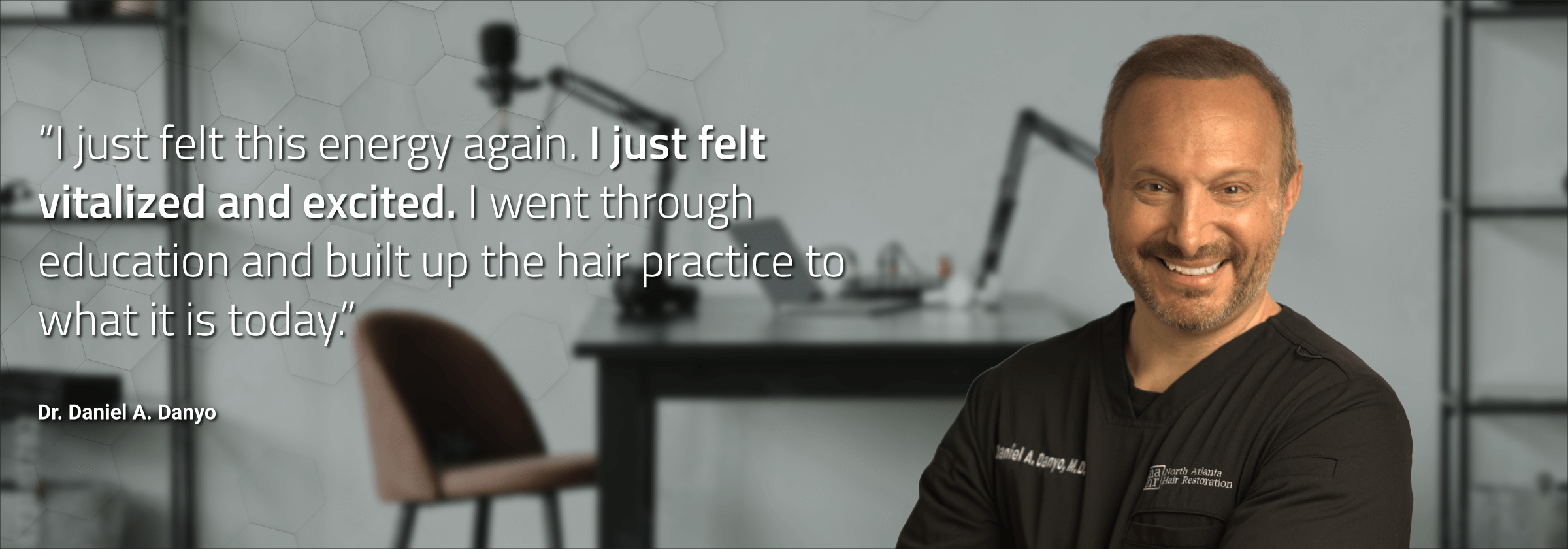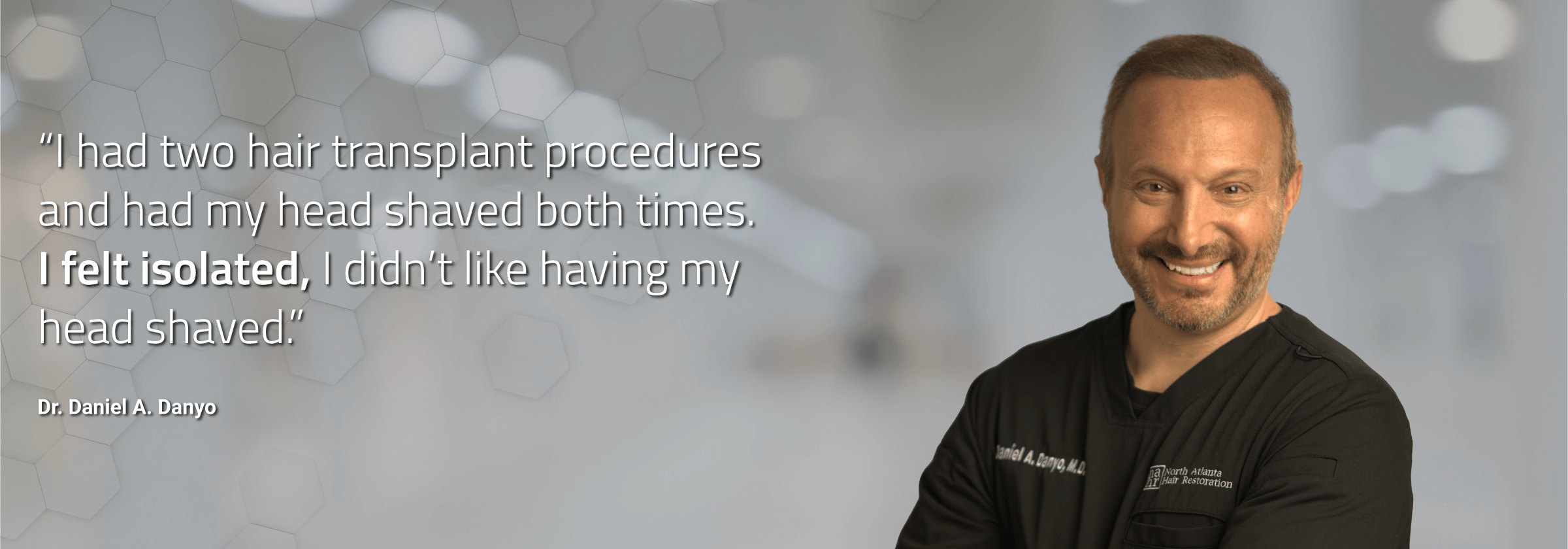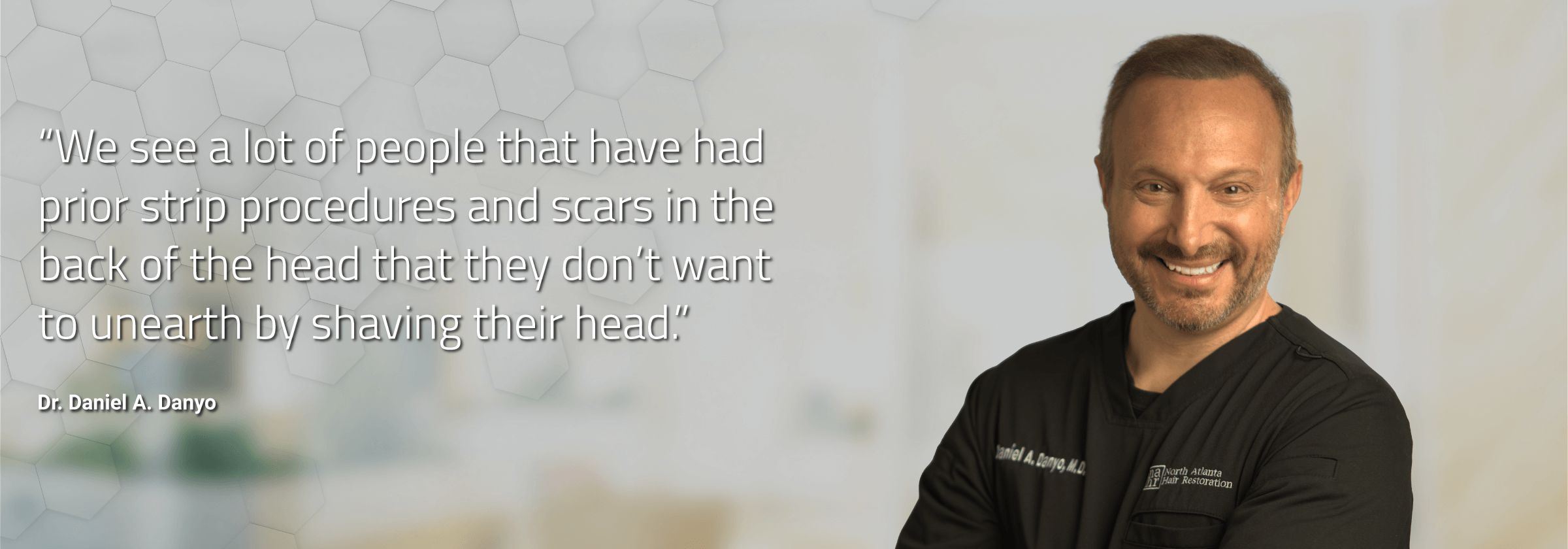The following is a transcript of Episode 1 of the Hair Restoration With Daniel A. Danyo podcast.
All episodes of the podcast can be found at Apple Podcasts, Google Podcast, and Spotify.
Dr. Danyo: When somebody follows up, particularly at one year after a hair transplant or we do some injection therapies to increase hair volume, you see definitive results. I mean, I usually say when people come back at six months from a hair transplant, it’s high fives and hugs, and that’s exactly what it is.
Clark: That was the voice of Daniel A. Danyo, M.D., founder and physician at North Atlanta Hair Restoration, a boutique medical practice solely dedicated to the diagnosis and treatment of male and female hair loss. You’re listening to Hair Restoration with Dr. Daniel. A. Danyo. I’m your host, Clark Buckner, and all season long, we’ll be speaking with Dr. Danyo about how he and his team at North Atlanta Hair Restoration are helping his patients transform their everyday lives for the better. In this first episode, we’ll discuss how Dr. Danyo found his passion for hair restoration after a career in rehab and pain management. We’ll also unpack some common misconceptions about hair restoration and explain how licensed physicians can change the story surrounding hair treatment, empowering patients to live their best lives. Now, let’s jump in.
Dr. Danyo: Hello. My name’s Daniel A. Danyo, M.D. I am the founder and sole physician at North Atlanta Hair Restoration in Alpharetta, Georgia about 30 minutes north of Atlanta.

Clark: Welcome. I am so excited about our new podcast. I’m really looking forward for this first episode to hear three things, the who, the what, the why. I really wanna understand more about just who you are, what’s on your mind, what’s on your heart with the work that you do. We’re gonna talk a little about what you do. We won’t get too much in the weeds today, but we certainly will talk a little about what you are doing on a regular basis. And then, finally, I wanna talk a little about the why, and why you love this work, and why you keep coming back to it. So, how about you start off on a little overview of the who, of just quick snapshot of…tell me about your passions and really what brought you to this.
Dr. Danyo: Sure. Well, Clark, I’m excited just like you are, excited for a number of reasons. For one, you know, having a podcast format like this will just kind of get people engaged and more interested in what the possibilities are in hair restoration because, quite frankly, a lot of people think it’s still back in the old days with plugs and kinda drastic results. But that’s one aspect. The other aspect is I’m just excited being a physician, doing what I do in this ever-changing and ever-growing industry. So, we have a lot to talk about.
Clark: And if you were to rewind it back, when did you first start this? What year was it? And when did you decide, why did you decide this was gonna be your calling?
Dr. Danyo: Sure. It was about 2011. I had a private practice doing pain management and physical medicine and rehab. I had a huge practice with 13 employees just for one physician, and that included my staff along with personal trainers, nutritionists, I had a massage therapist, physical therapist. And so, in 2011, the dynamics changed in medicine to where I just kinda got that burning feeling that I needed to change paths, particularly as it related to constantly seeing people in chronic and acute pain and just being almost like a gerbil on a wheel, just constantly running.
So, in 2011, I was sitting on the beach with my brother, and we were talking about things, and we were on vacation together. And he said, “You know what? You should go in the hair transplant.” Now, he’s a plastic surgeon, and he had just taken a small mini-course on hair transplants. And there was a new technique, which was FUE, which is what I will be talking about in-depth, which is follicular unit excision, which was really kind of an up and coming way of doing hair transplant. And he said, “You should do it. You’ve done all these injections with pain management. You’d be a great doctor doing this procedure.”
So, I did some research, and, actually, there was a course about two weeks later that was four-day intensive introductory course to hair transplant. And it was actually a cadaver course where you could actually do some of the procedures, practice them. And after that course, I just felt this energy again. I just felt vitalized and excited. I came home and I couldn’t stop talking to my wife about what I had learned and what I experienced. So, it was from that moment on that I just came up with a dedicated plan where I took my practice…which, actually, I had seen over 12,000 patients in my practice. I took that practice and, over a three-year period, closed it. And then, I went through education and built up the hair practice to what it is today.
Clark: Fantastic. It’s so interesting, it was your brother who made a suggestion. Do you normally take your brother’s advice?
Dr. Danyo: Well, he used to beat me up all the time, but he’s a good guy. And being two physician siblings, I mean, we went to the same college and the same medical school, I was the best man at his wedding, so we’re really close. And I think going through all the training in medical school, because I started out in general surgery, I always imagined myself more on the surgical side than kind of on the medical side. So, doing, you know, surgical procedures, not necessarily cutting people, but doing the follicular unit extraction, which is, in my mind, a surgical procedure. It kind of fulfills that destiny that I wished that I had taken kinda early on in my career in training.
Clark: Right. And we’re gonna come back to talk a little more about FUE and why you really stayed with that. But I’m curious to hear…when you were coming home and you were telling your wife about how excited you were when you started this. Now, tell me about the moment…I would love to hear your first time you saw someone’s loved one see the person you were helping with hair restoration, was that a significant time for you? What is that like?
Dr. Danyo: Yeah. So, the nice thing about hair transplant and hair restoration is that the results are totally visible. You know, with pain management, oftentimes, the results were not visible and then tangible. You didn’t know if somebody was actually in pain, when they weren’t, and vice versa. So, when somebody follows up particularly at one year after a hair transplant or we do some injection therapies to increase hair volume, you see definitive results. I mean, I usually say when people come back at six months from a hair transplant, it’s high fives and hugs, and that’s exactly what it is. I can typically hear the girls up front, my office staff, saying, “Oh, my gosh, look at you.” And then, when they come back into the exam room and I take a look, they are usually coming towards me, giving me a big hug or giving me a high five. And it’s an awesome feeling.
Clark: That’s what it’s all about. Excellent. So, let’s now start talking a little about maybe the change and the shift of the perception of this. You were saying when you first got started in this, there was just a certain, I don’t know, stigma or it was just a different time.

Dr. Danyo: Yes.
Clark: That’s just what some people think about when thinking about hair restoration or a hair transplant. So, what’s the biggest change to where we’re at today?
Dr. Danyo: Well, a lot has changed. For one, kind of the perception of hair transplant was definitely made worse through the kinda ’70s and ’80s when full-thickness skin graft plugs were being placed. And that was where they took a 4-millimeter, full-thickness coring device, would core out about, you know, 8 to 12 follicles, and then core out a full-thickness graft in the front, and then place those hairs in there, and stitch them in. And what happened is, I mean, it looked like doll’s hair.
Clark: Yikes.
Dr. Danyo: And it just did not look real. And so, the term plugs with hair transplant began. And it wasn’t really until about 2001 when, you know, some leading physicians in the hair restoration surgical world said, “You know what? Why are we taking these big plugs? Why aren’t we taking single units?” So, that’s when follicular unit…it was called extraction at that time. It’s now called follicular unit excision, or FUE, really kind of started to germinate as a bonafide procedure. And then, I would say as, you know, things kinda went through different cycles, and technology, and punch design improved…it wasn’t really until about 2011, 2012 right when I was getting into this realm that FUE started taking on a lot more of a presence. And, actually, the public started demanding it because the other procedure, which is still used frequently…and I’m not here to demonize what’s called follicular unit transplant, also known as FUT or strip harvest surgery, where, you know, full-thickness skin is extracted from the scalp in kind of a linear strip and then the skin edges are sewn. But the fact is people did not want that linear scar that was left behind and they were looking to do FUE. And it wasn’t until, actually, last year that the number of FUE cases actually outpaced the number of FUT cases. And that is continuing to evolve where there are more and more physicians offering FUE and, you know, I would say, less patients wanting to go down the FUT route because of that linear scar.
Clark: So, there’s a lot to navigate. It sounds like there’s a lot to…for something that maybe already has that old stigma, and then there’s all these options, all these things, that can maybe be overwhelming. I mean, already if someone’s experiencing this, I would imagine they’re maybe already feeling a flood of emotions, but now you add on all of this, other marketing messages you hear, everything. So, you know, if you were to simplify everything and convey to someone, how do you cut through the noise and just…to someone like me even. Like, I’m really excited to be learning more about this. But what would you say to someone like me of just, like, where we’re at now.
Dr. Danyo: Well, I think the first thing, and this is an issue in hair restoration, is that a physician needs to be involved right from the start. And, unfortunately, there’s been more of a sales-oriented approach when people are initially evaluated. But there are a couple of things that need to be determined from a medical perspective. One, what type of alopecia is going on because there’s some alopecias where, you know, a hair transplant is actually contraindicated. So, you need to make the right decision.
Secondly, you need to determine what kinda density they have and really come up with short-term and long-term goals that are not there to generate revenue and sales but are there really for the best interest of the patient. And I feel that the best interest of the patient is ingrained in physicians because we took the Hippocratic oath and it’s part of our professional being. And, again, I’m not here to demonize people, but there is a true problem with that sales approach and the fact that, unfortunately, doctors are not as involved as they should be. But at least at my clinic, I do all the consults, follow-ups, and I do the entire case. And I think it lends a lot of value to the patients that I see.
Clark: You’re totally invested from the very beginning to the end.
Dr. Danyo: Exactly. So, back to your question. You know, once we do the evaluation, then I show them kind of in the back of their head, which is called the donor site. That’s where you take hairs and then you can move them up top. They’re genetically different than the hairs on the top and they’re not programmed to die. But I show them, “This is what your density should look like.” And then, we go up into the balding area. And they can see, you know, under a microscopic view that, “Hey, there’s a difference. We need to do something about it.”
The other thing is not all patients are really surgical candidates, and many are more medical candidates for injection therapies such as platelet-rich plasma injection therapy or some of the stem cell activating injections that are evolving, medical management with even some lotions and also medications by mouth. So, it’s not a sales pitch that determines all this stuff, it’s a medical approach, and one that has to be authentic and honest.
Clark: It sounds like everyone has their own story, of course, right? Everyone’s different, you know, no one’s the same as the next person. If you were to maybe zoom it out and maybe generalize a little bit, or maybe just the first one or two things coming to mind, I’m curious to hear what are some of the hesitations, what are some of the pain points, what is one feeling. Based on just if you were to kind of put all this data together from the many patients that you’ve helped, when you first meet with them, what are they typically feeling?
Dr. Danyo: Well, there’s a lot of hesitation. For one, mainly because of the old plug, you know [crosstalk 00:15:13].
Clark: They’re scared of that, they feel that fear. Okay.
Dr. Danyo: That they wanna keep this quiet, they want it concealed. It’s so much more private than if you were to get botox to the face, or skin resurfacing, or even a facelift. Your hair is extremely personal. The other thing is people with hair loss are negatively affected psychologically, a lot more so than, say, having wrinkles on the face, having skin discoloration, obesity, you know, other cosmetic issues. They are definitely very sensitive about their appearance as it relates to their hair. So, they come in with kind of, you know, a bag full of emotions.
And, again, if you come across in a non-sales pitch, and you do the assessment, and say, “You know what? I can show you pictures of how you could look. And, you know, these are the potentials and possibilities,” that’s when people get disarmed and they say, “You know what? I think I’m ready to move forward.” But I have a lot of people that say, “I’m just here to have you answer questions. I don’t wanna sign anything. I don’t wanna commit to anything.” So, it’s a process, and I think it’s important to walk people through that process the best we can.
Clark: So, this is intensive for you. If you use that approach where the physician is involved from the very beginning and you’re walking alongside on this journey of something that can feel like you were just describing, there’s a bag of emotions. So, what is your why? Why do you continue to do this? I would love to talk a little about your why.

Dr. Danyo: Sure. Well, first of all, I’ve had two large hair transplant procedures, both with FUE. So, I’ve been down the road of hair loss and, you know, I’ve spent many hours looking in the mirror or just wishing that things were better. And I feel like I’ve had great results. So, you know, just kinda going through the process, not having a lot of pain, I mean, it was a lot easier than I ever thought I would be. So, that’s a huge component of my why. The other thing is, you know, as a physician, I am really into kind of the human condition. And I just felt with my other practice where I was literally having to see 40 to 50 patients a day almost just to make the overhead with some of the reimbursement issues and overhead issues that I was facing, and I could not spend quality time.
I’m a people person, I like to spend time with people, and there’s no better way than with hair restoration, especially if you’re doing, say, an eight or nine-hour case. And I’ve met some incredible people. We talk about things related to life. For many of them, I’ve actually even become a coach because I have such a background in pain management, working out. I had a personal training gym in my office for 10 years. We’d talk about nutrition. And so many people, patient-wise that I see, are at a very vulnerable stage in their life. We had a guy that recently lost his wife. They were married for like 28 years, and now he was gonna have to go out on the market, so. But he had, you know, a lot of issues. But we also talked about, “Well, you could lose a few pounds,” and what’s going on nutritionally. And I gave him some books to read and things like that. And, hopefully, he’ll take my offer on it.
So, I just feel that I can actually be a true doctor. And I feel like doctors should be great coaches. And, unfortunately, the way, you know, healthcare has changed, it’s a numbers game. And it’s really impacting the physician-patient relationship in, I think, a very negative way. And it’s great having total control over that and be available. So, I just love having those conversations and kind of, you know, sparking people to kind of ignite that fire, which is great.
Clark: That’s wonderful. Well, what I’m hearing loud and clear is your sincere interest of help from the beginning all the way through. And I feel like you having your own practice, it gives you that flexibility to be able to do that instead of making it into a numbers game. So, you know, you’re pretty bought into their lives, and everyone has different reasons, but it makes sense. So, I am excited about this podcast and how it can be a way to just continue to learn about a topic that has some misconceptions around it, but also where we’re at today and the realities of what you’re able to do. It’s really unbelievable.
Dr. Danyo: Absolutely. And, you know, I’m happy to just even venture outside of hair restoration a little bit and talk about some of the other issues that oftentimes are associated with people that feel that they’re not in their game. I mean, hair restoration, when you get it, it almost instantly makes you feel and look younger. So, you know, kinda getting that youthfulness back and touching on other life scenarios to kinda propel people. But I think we have a lot to talk about. I’m very excited.
Clark: Wonderful. Well, thank you. And I look forward to talking to you soon.
Dr. Danyo: Thank you, Clark.
Clark: Thanks for listening to “Hair Restoration” with Dr. Daniel A. Danyo. You can book your consultation today with Dr. Danyo by simply calling (678) 845-7521 or online at nahairrestoration.com. And be sure to subscribe, rate, and review this podcast wherever you listen to your audio content.

